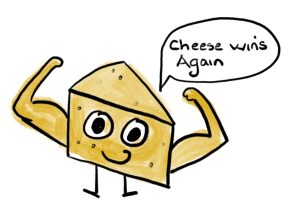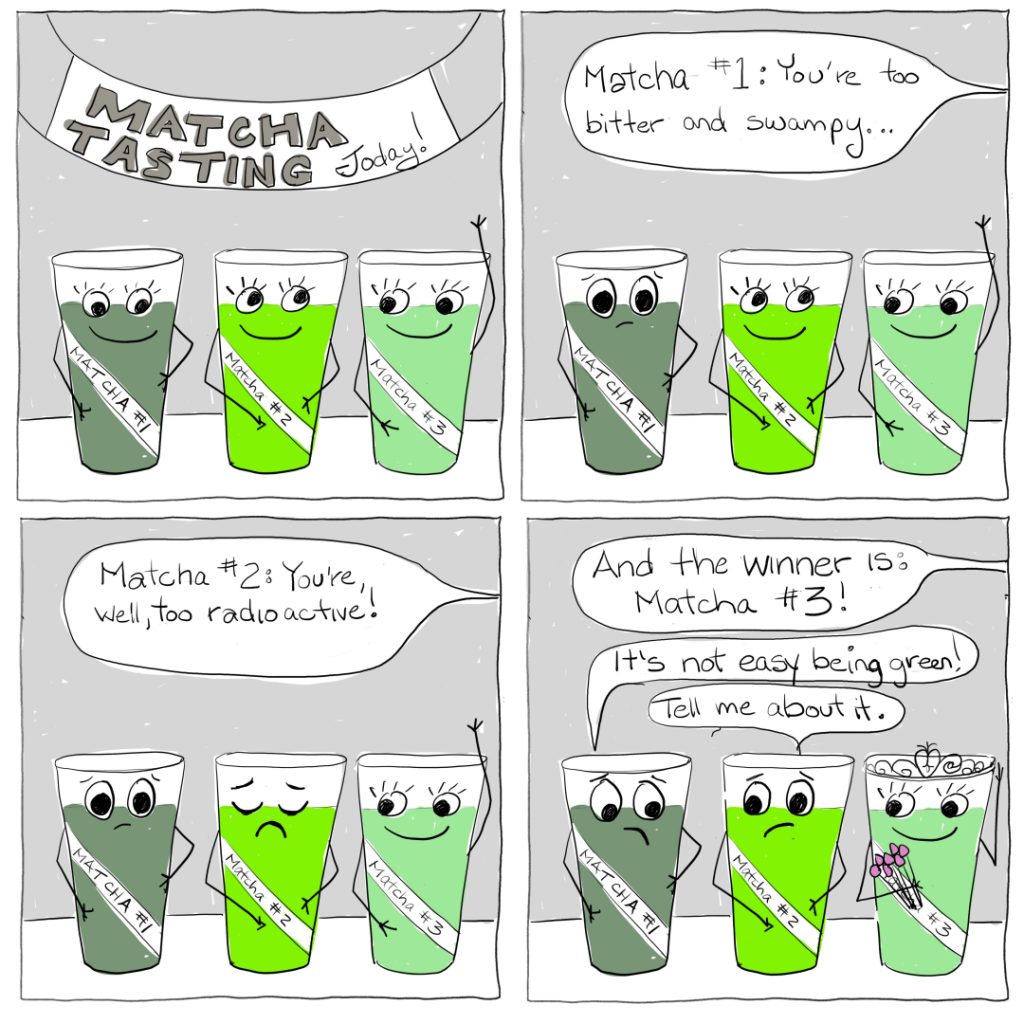
You would think drinking Matcha lattes to combat my vitamin D deficiency and osteopenia would be a great idea, but nothing is EVER as simple as it seems.
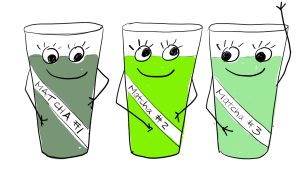
I know Matcha good for me, but I can’t get past the fact that it tastes like ground up leaves mixed into skim milk.
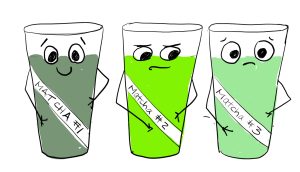
To be fair, I shouldn’t be surprised that ground leaves mixed with skim milk tastes like ground leaves mixed with skim milk.
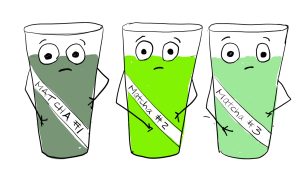
The Matcha would probably taste better if I made it with 2% or whole milk, instead of skim. But that’s out because I need to watch my cholesterol.
The reason I developed a vitamin D deficiency in the first place is because, about two years ago, I finally heeded my dermatologist’s advice and started taking sunscreen seriously.
Did I mention that I have a history of kidney stones–which the calcium in the milk could, potentially, contribute to?
At 61, maintaining my health has become a delicate balancing act. I have to choose between some combination of skin cancer and wrinkles, heart disease, kidney stones, or osteoporosis.

I tried drinking regular lattes first, instead of matcha, but that didn’t work out.
Straight coffee was out because it gives me a stomach ache (sometimes accompanied by a dash to the bathroom.)
But coffee is my all-time favorite ice cream flavor.
“So I’m just going to add a couple of tablespoons of coffee to a glass of milk,” I explained to my daughter, Lindsey.
“Oh, you mean you’re making sugar-free melted coffee ice cream,” she said.
(Did I mention that I’m trying hard to cut down my sugar intake?)
Isn’t it great when your children get you?
 Coffee milk tasted great but I had to give it up after a week because:
Coffee milk tasted great but I had to give it up after a week because:
Reason #1: I have no caffeine tolerance–which meant that coffee milk drinking triggered obsessive toe tapping. Like my feet had a mind of their own.
You know how annoying it can be when you’re waiting to see the doctor and the guy sitting across from you won’t stop tapping his feet? I was doing that to myself!
Reason #2: The acid in the coffee gave me canker sores.
So now the health perils I had to choose between included skin cancer and wrinkles, heart disease, kidney stones, osteoporosis, canker sores and mild akathisia.
And so for now, Matcha it is!

I make my own Matcha lattes at home. For flavor and to give it a little body, I add a splash of half and half.
I guess I need to do the math to see if the half-and-half plus skim milk equals less cholesterol than if I used whole milk.
–
I wasn’t sure how to make Matcha so I Googled some recipes. The first recipe completely overwhelmed me. Just the equipment was crazy complicated. Did you know that traditional Japanese Matcha-making requires a special bowl, a strainer, a bamboo whisk, and a tiny scoop?
I had no idea matcha is so complicated!

Knowing that I am the type of person who will spend $150 on supplies for an art class, then only go twice, I decided that rather than following my natural urge to buy all the stuff, it would be better to look for a recipe that used equipment I already owned.

I searched a bunch of other recipes which warned me about the perils of using water that was too hot (burns the tea and makes the matcha bitter). Another potential pitfall is whisking in a circle instead of a “Z” configuration (you won’t get good froth).
This was a bit overwhelming so, I simplified it down to: you mix a small bit of Matcha powder with hot–but not boiling– water. Then add hot milk and whisk.
It was all I could handle.

It’s best not to look at the Matcha at the add hot water stage. If the color it makes were a Benjamin Moore paint sample, the name of the color would be swamp.
Or pond scum.

One of the Matcha recipes I found online said something to the effect that: Matcha is to regular tea what diamonds are to plain old rocks.
After looking at the murky mess in my cup, I thought: oh, that makes sense. It’s an item whose perceived value is the result of a well-executed marketing campaign.

Lindsey suggested I try a Matcha that one of the influencers she follows on Instagram raves about. $169 for a starter kit with just a few ounces of Matcha. Crazy!
I looked for a highly rated Matcha on Amazon and the price wasn’t that much different.
I finally bought a small package at my local health food market. Still pricey, but at least I could start with just a small amount.

And then there is the milk frothing. If I’m being honest, the frothy milk was 75% of the attraction.
I can’t drink coffee but I love milk foam!
Sometimes when I’m out with friends, I’ll suffer the acid stomach, jitters and other perils of coffee just to have the foam.

Because I was a milk frothing newbie that process took a little trial and error too.
Using a tiny hand whisk wasn’t getting much froth so I tried one of those battery powered frothers you buy at IKEA.
The first time I used the frother, it turned the entire cup of Matcha into a whirlpool. Not a small one like at the bottom of your kitchen drain, but a large one. Like the one in the Odyssey that swallows entire ships.
Yes, matcha splashed all over the counter.
I remembered that famous line from Jaws about needing a bigger boat.
I’m going to need a much bigger mug, I thought.

Now what I do is heat the milk in the microwave in a Pyrex measuring cup. I pour ¾ of the milk into the swamp mixture–which I’ve prepared in the serving mug. Then I add the half-and-half to the hot milk and froth it in the measuring cup.
Let me say that this works great.
Best milk froth imaginable.
Almost like unsweetened whipped cream.

At this point, Lindsey stepped in again.
“If it looks like pond scum, it isn’t good Matcha,” she said. Evidently good matcha is a really pretty spring green. Like baby pea shoots or just sprouting grass.
I tried some Matcha at Lindsey’s house and she was right. Pretty color. Nice flavor. She said her brand costs $30 including shipping–but would last a very long time. So I ordered my own.

While I was waiting for my matcha to arrive, some friends invited me to meet them at a local coffee shop. Curious, I ordered an iced matcha latte.
Beautiful mint color and very yummy. It tasted exactly lIke a green tea mochi ice cream–which I LOVE. But of course the reason it tasted like a green tea milkshake was because it was sweetened. Very sweetened.
I think I mentioned earlier that I’m trying to cut down on sugar.
So no more iced matcha lattes in coffee shops.

Soon, my mail-order matcha arrived. It came in a tiny canister about the same size as a small jar of chopped garlic.
While the matcha powder was indeed the promised spring green, it only filled ⅓ of the canister. Which was tiny to start with. That’s all the space 20 grams of matcha takes up.
At first I felt a little like I’d been duped but then I remembered. That 20 grams was going to go a very long way.
But was it?
The matcha company recommended 4 grams of matcha per serving. That meant my $30 matcha was only going to make 5 servings. Not even a week!
If you add in the cost of milk, that’s about $7 per matcha.
I know this shows how old I’m getting–and how cheap–but I couldn’t help thinking that $7 was a lot to spend on a beverage you make at home.
If I felt like spending $7 on a tea beverage, I’d go to Starbucks.

By the next time I discussed matcha with Lindsey, she had come to the same conclusion as me–that matcha was kinda expensive.
“My friend said that my matcha order would last a whole month. But that’s only true if I only make it once a week,” she said.
So I guess she’s over matcha now too.

Since I still had some matcha in the canister, I decided to experiment.
Instead of adding half-and-half, I used 1% milk. And if I poured ⅔ of the warm milk into the matcha, then used my IKEA frother to froth the rest, I got pretty nice milk froth.
REALLY nice milk froth.
 So the milk froth has lived up to my expectations.
So the milk froth has lived up to my expectations.
But the matcha?
It either tastes bad or is super expensive.
I’m going to use up my canister, but perhaps I need to choose another source of Vitamin D.
Cholesterol be damned–I think I hear my old friend, cheese, calling my name.
